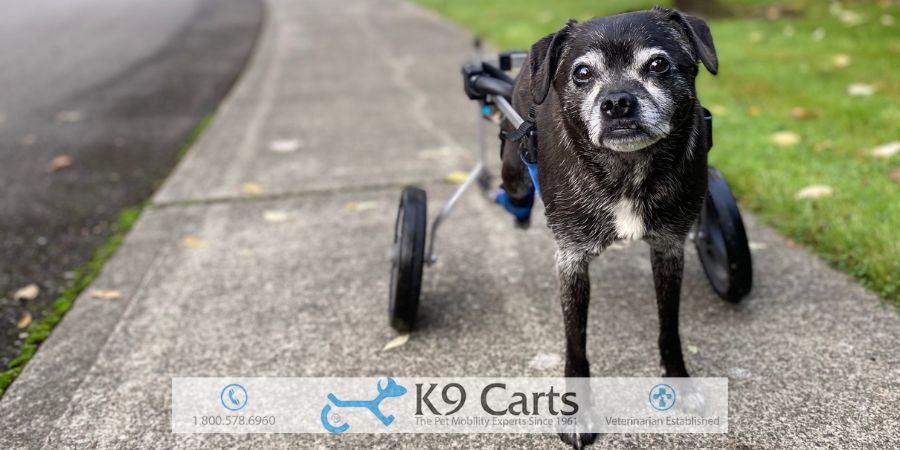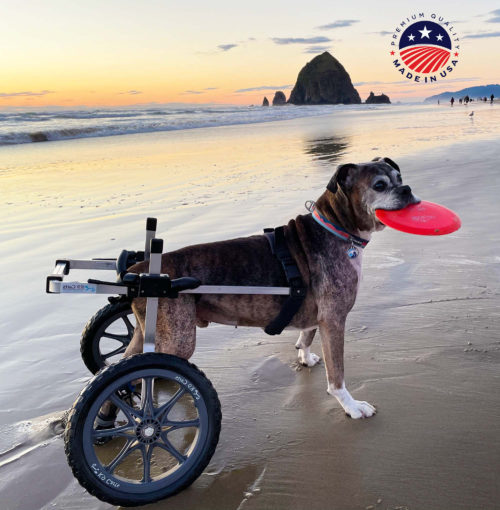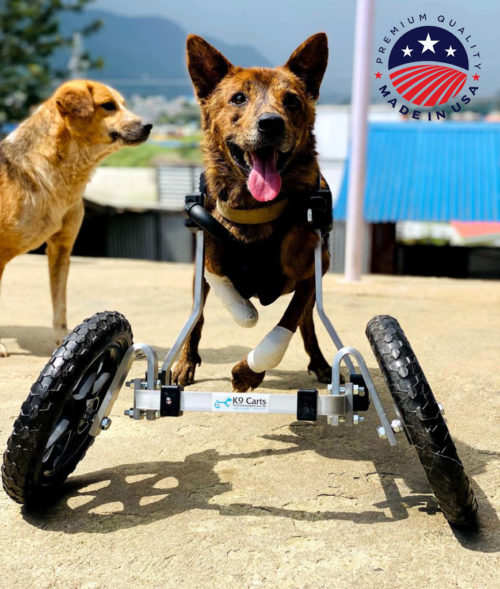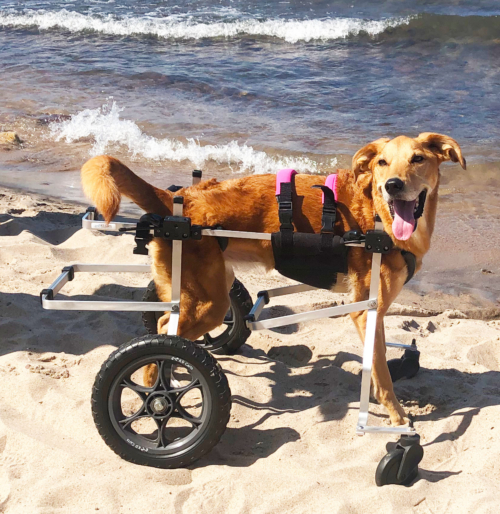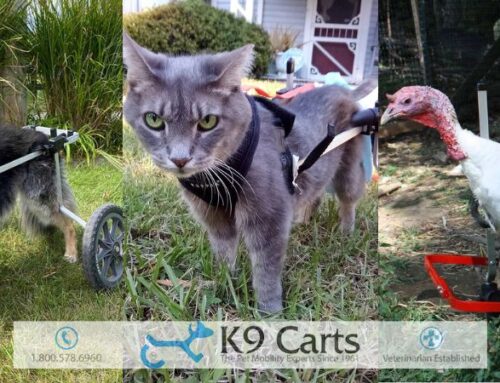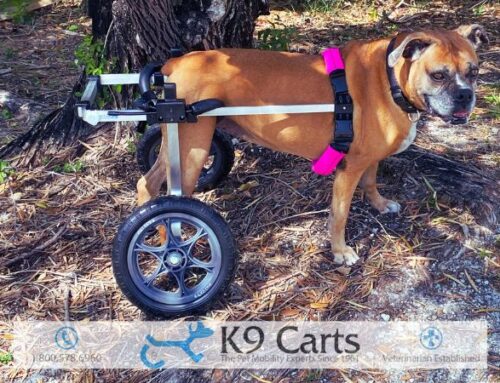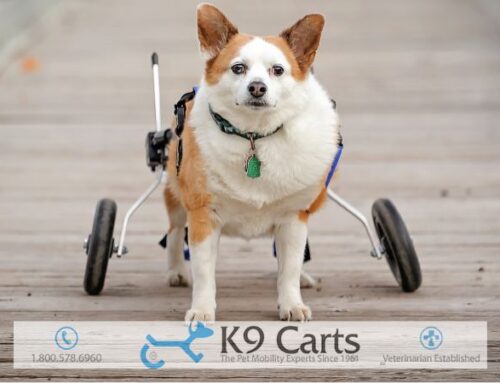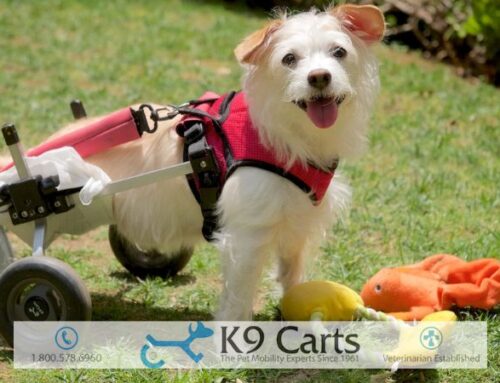Every pet owner’s worst nightmare is seeing their beloved companion suffer. As the friends and guardians of these innocent souls, we’re entrusted with the duty of ensuring their well-being, especially when they can’t express their pain or discomfort.
Imagine one day your dog appears healthy, running around and playing, and the next day, they can’t stand up or walk on their back legs. Such situations are heart-wrenching and often leave us feeling helpless and anxious.
The inability of a dog to use its hind legs can arise from a myriad of reasons. Understanding these potential causes and the immediate steps to take can not only aid in faster recovery but also bolster our confidence in providing our furry friend with the care they deserve.
Through this article, we aim to shed light on the potential reasons for such sudden incapacity and guide you through the necessary actions, including how mobility solutions like custom-built wheelchairs can transform your dog’s life.
Common Reasons Your Dog Can’t Walk on His Back Legs Suddenly
When confronted with the distressing sight of our dog struggling with their back legs, our first instinct is to ask, “Why?” The causes can range from simple injuries to more complex medical conditions. Understanding the root of the issue can provide clarity on the prognosis, potential treatments, and measures to prevent recurrence.
This section will delve into some of the most prevalent reasons your dog might be facing difficulty using its hind legs, from traumas to degenerative ailments. With a solid grasp on the potential causes, you’ll be better prepared to aid your furry companion through their recovery journey.
Trauma-Related Causes
Traumatic events, though unfortunate, are not uncommon in a dog’s life. Whether it’s a minor fall or a major accident, any form of trauma can potentially harm your dog’s ability to walk. Here’s a deeper look into trauma-related reasons that might be hindering your pet’s mobility.
Fractures or Sprains: These are among the most immediate culprits one might think of. A simple misstep, an awkward landing, or an unfortunate collision can lead to fractures or sprains. Signs might include swelling, localized heat, or even an apparent deformity.
Dislocated Joints: A joint dislocation happens when bones are forced out of their natural position. This can happen in various circumstances, such as rough play or a minor accident. A dislocated joint can be quite painful, and it’s usually easy to recognize due to the abnormal alignment of the leg.
Impact Injuries: These injuries are usually the result of direct trauma, like being hit by a car or a heavy object. Such incidents can cause a range of problems, from bruises and contusions to more severe internal injuries. Always remember that even if an external wound isn’t visible, internal injuries can still be present.
Degenerative Conditions
Aging and genetic factors can lead to degenerative conditions in dogs. These ailments can be slow-progressing and might not manifest evident symptoms until they’ve advanced considerably. Awareness of these conditions can help in early detection and management, enhancing the quality of life for our pets.
Hip Dysplasia: This is a genetically inherited condition, more common in larger breeds. It refers to an improperly formed hip joint, where the ball and socket don’t fit together correctly. Over time, this misalignment can cause painful wear and tear. Early signs include stiffness, trouble rising, or a bunny-hopping gait.
Osteoarthritis: Often a consequence of hip dysplasia or other joint issues, osteoarthritis is the degeneration of the joint cartilage and the underlying bone. Symptoms evolve gradually, starting with mild stiffness and progressing to significant pain and immobility.
Degenerative Myelopathy: This is a progressive spinal cord disorder that affects older dogs, particularly German Shepherds. Early symptoms are subtle, like dragging of the hind feet. As it progresses, dogs might cross their back legs when walking or even collapse.
Intervertebral Disc Disease (IVDD): IVDD is the result of premature aging and degeneration of the discs between the vertebrae of the spinal column. When these discs rupture or become herniated, they can press on the spinal cord, causing pain, nerve damage, and even paralysis.
Neurological Issues
The nervous system is an intricate web that controls every movement and sensation in a dog’s body. When something goes amiss within this system, it can manifest as an array of mobility issues. Here’s a brief exploration of neurological problems that might be preventing your dog from walking on their back legs.
Spinal Cord Injuries: Much like in humans, a dog’s spinal cord is the main pathway for nerve impulses to and from the brain. Any injury to the spinal cord can disrupt this flow, potentially leading to partial or complete paralysis of the hind legs. Causes can range from trauma, like a fall or accident, to non-traumatic factors, such as blood clots or inflammatory disorders.
Tumors Affecting the Nervous System: Tumors or growths, whether benign or malignant, can press on the spinal cord or other crucial parts of the nervous system, leading to conditions like Cushing’s syndrome. This pressure can result in pain, weakness, or loss of coordination in the hind legs.
Inflammatory Diseases of the Central Nervous System: Conditions like meningitis or encephalitis, which are inflammations of the brain or its surrounding membranes, can also affect a dog’s mobility. Though these conditions primarily affect the brain, their symptoms can manifest in the hind legs due to the interconnected nature of the nervous system.
Other Medical Conditions
While trauma, degenerative issues, and neurological problems are often the primary suspects when a dog can’t use their hind legs, several other medical conditions might be at play. These conditions may not be directly related to the limbs but can still impact mobility.
Lyme Disease and Other Tick-Borne Illnesses: Ticks, though tiny, can bring about significant health issues. Lyme disease, caused by the Borrelia burgdorferi bacteria transmitted through tick bites, can lead to joint pain and swelling. This discomfort might manifest as your dog limping or having a reluctance to move.
Canine Influenza: Commonly known as dog flu, this viral infection predominantly affects the respiratory system. However, in severe cases, it can lead to generalized muscle pain or stiffness, impacting a dog’s ability to walk or stand.
Peripheral Neuropathy: This condition refers to the damage or disease affecting peripheral nerves. When these nerves, which connect the central nervous system to the rest of the body, malfunction, it can result in muscle weakness, twitching, or even paralysis.
Immediate First Aid and Temporary Interventions
While the ultimate course of action should be determined by a veterinarian, there are steps we can take to alleviate our dog’s discomfort and prevent further injury in the interim.
Keep your dog comfortable: The use of soft blankets and cushions can provide relief. These can act as barriers against hard surfaces, offering a comfortable resting spot. Ensure that their environment is free from obstacles that could cause further harm.
Seek emergency veterinary care: If your dog displays signs of pain, distress, or any severe symptoms, don’t hesitate to seek immediate veterinary attention. Time can be of the essence, especially if the cause is a trauma or a rapidly advancing condition.
Hydration and feeding concerns: A dog with mobility challenges might struggle to access their water or food bowls. Ensure they remain hydrated and nourished by bringing the bowls closer to them or assisting them in drinking or eating if needed.
Diagnosing the Cause of Your Dog’s Inability to Walk on Its Back Legs
A definitive diagnosis is crucial, as it shapes the subsequent treatment plan. Veterinary professionals employ a combination of clinical examinations and advanced diagnostic tools to determine the underlying cause of a dog’s mobility challenges.
Physical examination: This initial assessment provides insights into the dog’s overall health and potential pain points. By observing your dog’s gait, posture, and reflexes, the vet can get preliminary information about the nature and severity of the problem.
X-rays and imaging tests: These tools offer a closer look at the skeletal structure and internal organs. X-rays can reveal fractures, dislocations, and certain degenerative conditions. Advanced imaging techniques like MRI or CT scans can give a detailed view of soft tissues, including muscles, ligaments, and the spinal cord.
Blood tests and other laboratory diagnostics: Blood samples can provide a wealth of information, from the overall health status to specific conditions. For instance, Lyme disease or canine influenza might be confirmed through blood tests. Additionally, urinalysis or fluid samples from affected joints might be analyzed to rule out infections or other anomalies.
Neurological assessments: If a neurological issue is suspected, specialized tests assess the dog’s nerve functions and reflexes. These evaluations can pinpoint nerve damage, inflammation, or other disorders affecting the nervous system.
Treatment Options and Rehabilitation
Once a diagnosis is established, the next step involves devising a treatment plan tailored to your dog’s unique needs. Treatment aims to address the root cause, alleviate pain, and restore mobility. Let’s delve into the therapeutic options available.
Medical Interventions
Pain relief and anti-inflammatory medications: Nonsteroidal anti-inflammatory drugs (NSAIDs) or other pain relievers can significantly alleviate discomfort. It’s essential, however, to use these under veterinary supervision to prevent potential side effects.
Surgical options where applicable: Conditions like severe hip dysplasia, certain fractures, or spinal cord issues might necessitate surgical interventions. The aim is to correct anatomical issues or remove obstructions, thus alleviating symptoms.
Alternative therapies: Acupuncture and laser therapy are gaining traction in veterinary care. Acupuncture can help with pain management and improve nerve function, while laser therapy can reduce inflammation and promote tissue healing.
Physical Rehabilitation
Passive range-of-motion exercises: These involve manually moving your dog’s hind legs in a specific range to maintain joint flexibility and muscle strength.
Hydrotherapy: Water’s buoyancy reduces strain on the joints, making it an excellent medium for rehabilitation. Dogs can walk or swim in controlled environments, promoting muscle use without the risk of injury.
Strength and conditioning exercises: As your dog’s condition improves, more active exercises can help regain muscle mass and improve coordination.
Importance of Custom Mobility Solutions
The journey to recovery or adaptation for a dog facing hind leg challenges is multifaceted. While medical interventions play a pivotal role, the importance of mobility solutions cannot be understated. Let’s dive deeper into how these aids can transform a dog’s life.
Dog Wheelchairs: Bringing back mobility and joy
Dogs are inherently active and curious creatures. An impediment to their mobility can impact their mental well-being as much as their physical health. Wheelchairs serve as extensions to their bodies, granting them the freedom to explore, play, and engage with their environment. But not all wheelchairs are created equal. A custom-built wheelchair, precisely tailored to a dog’s measurements and needs, offers unparalleled comfort and support.
K9 Carts, with its dedication to restoring mobility to pets, designs wheelchairs that cater to individual requirements. Factors like the dog’s weight, size, specific disability, and even the terrain of their living environment are considered. This meticulous approach ensures that the wheelchair isn’t just a mobility aid, but a seamless extension of the dog’s body.
Discover K9 Carts Dog Wheelchairs
Rear Lift Harnesses: Helping your dog stand up
There are moments when a dog might require assistance with basic actions like standing up or tackling stairs. This is where rear lift harnesses prove invaluable. By offering support and reducing strain on the hind legs, these harnesses empower dogs to perform everyday activities with ease.
K9 Carts offers two exceptional lift harnesses:
Help’Em Up Harness: This full-body lifting harness ensures that the weight distribution is even, preventing any undue strain on a specific body part. With its ergonomic design, it’s an indispensable tool for dogs with significant mobility challenges.
Learn more about the Help’Em Up Harness here.
EZ Lift: Designed for targeted support, the EZ Lift focuses on the rear portion, making it ideal for dogs primarily facing hind leg issues. Simple yet effective, it provides the necessary boost for tasks like climbing stairs or getting into vehicles.
Learn more about the EZ Lift here.
Incorporating these custom mobility solutions into a dog’s life ensures they experience minimal disruptions. After all, every dog deserves to live a life filled with joy, exploration, and boundless enthusiasm. With the right tools, we can guarantee they continue to do just that.


